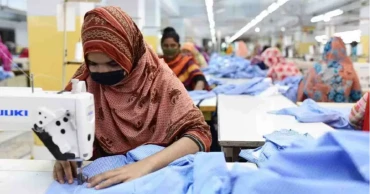apparel export
Bangladesh holds 2nd spot in apparel export as Vietnam gains ground
Despite holding its position as the world’s second-largest apparel exporter, Bangladesh faces growing competition from Vietnam, which is emerging as a formidable rival in the global market.
According to the World Trade Organization (WTO) data for 2024, Bangladesh secured $38.48 billion with a growth rate of 0.21%, while Vietnam emerged as a strong contender with a notable growth rate of 9.34%, amounting to $33.94 billion in exports.
The global apparel market has reached a total size of $557.50 billion, showing a 7.08% growth from the previous year's $520.62 billion, according to the WTO data for 2024.
China, leading the market, achieved $165.24 billion in exports, marking a modest growth of 0.30%. Following closely, Bangladesh secured $38.48 billion with a growth rate of 0.21%.
Vietnam emerged as a strong contender with a notable growth rate of 9.34%, amounting to $33.94 billion in exports.
Turkey contributed $17.91 billion to the market, while India, Cambodia, Pakistan, Indonesia, and the USA recorded export figures of $16.36 billion, $9.89 billion, $9.28 billion, $8.73 billion, and $7.00 billion, respectively.
Growth percentages varied across these countries, with figures ranging from 24.19% to -4.42%.
Bangladesh's apparel export to US rose to $7.34 billion in a decade: US Report
Market share analysis reveals China holding the largest share at 29.64%, followed by Bangladesh at 6.90%. Vietnam, Turkey, India, Cambodia, Pakistan, Indonesia, and the USA captured market shares of 6.09%, 3.21%, 2.94%, 1.77%, 1.66%, 1.57%, and 1.26%, respectively.
Despite the challenges posed by the COVID-19 pandemic, the global apparel market has shown signs of recovery and growth. But, new challenges and issues continue to emerge, shaping the dynamics of the industry.
Mohiuddin Rubel, former director, Brand BGMEA and Managing Director, Bangladesh Apparel Exchange told UNB that Bangladesh’s competitors increased in the global market.
Apparel makers highlight importance diplomacy, branding eyeing 100 bln dollar industry
The US tariff imposed for Bangladesh would be increased if the tariff barrier continues, he said.
5 months ago
Dip in US market fails to dent apparel sector's growth momentum
Bangladesh’s apparel exports in the first nine months of the current fiscal, i.e. July 2022-March 2023, jumped by around 12 percent - an impressive clip by anybody's standards. It is even more impressive when you consider that apparel exports to the US, which has been its largest single market, actually declined 5%.
On the other hand, exports to the European Union overall, kept up with the pace of the industry. Apparel exports to the European Union during July-March of the 2022-23 fiscal also jumped by almost 12 percent (11.8% to be more precise), to $17.61 billion, compared to the $15.75 billion recorded in July-March of the 2021-22 fiscal, according to BGMEA Director Mohiuddin Rubel.
The overall growth in apparel export has been an impressive 12.2%, from $31.43 billion in the first 9 months of FY 2021-22, to $35.25 billion in the first 9 months of FY 2022-23.
Read More: Speakers emphasise safety, security in industries to avert another Rana Plaza tragedy
This highly impressive growth figure has been achieved despite the industry's exports to the US having actually declined by 5 percent - to $6.25 billion in the first 9 months of the current fiscal, from the $6.6 billion recorded last year.
Bangladesh’s apparel exports to the UK and Canada reached $3.84 billion and $1.08 billion with 14.04 percent and 17.68 percent growth respectively.
Among the major markets in the EU, apparel exports to Germany declined by 4.16% year-over-year while exports to France and Spain grew by 25.23% and 18.82% year-over-year respectively. On the other hand, exports to Poland declined by 14.86%.
Read More: BGMEA writes to US policymakers for duty-free access for US cotton-made apparel.
The most significant growth was reported in the nontraditional sector. The apparel export to nontraditional market increased by 34.74% to US$6.44 billion in July-March period of FY 2022-23 from US$ 4.78 billion in the same period.
Mohiuddin Rubel, BGMEA director, said: “BGMEA is working to facilitate the exploration of new markets, as well as working on policy reforms to facilitate and simplify business.”
“Our efforts will be continued, and it’s time for all of us in the industry to promote and highlight our strengths in new products and new markets before the global customers (existing and new ones) to explore new opportunities. That will help sustain our growth in the longer term,” he added.
Read More: Apparel exports to EU grew 35.69% in 2022.
2 years ago
Apparel shipments rose by 16% to $23bn during July-December: BGMEA
Bangladesh's apparel exports reached $22.97 billion, growing 15.56 percent year-on-year, during July-December, the first six months of 2022-23 fiscal, the Bangladesh Garment Manufacturers and Exporters Association (BGMEA) said Monday citing the Export Promotion Bureau (EPB) data.
Knitwear accounted for $12.66 billion and woven garments accounted for $10.33 billion of the shipment, with a 13.42 percent and 18.29 percent growth year-on-year, respectively.
"The Apparel industry fared well in December. With a 15.35 percent growth, December 2022 fetched $4.67 billion from readymade garments (RMG) exports, the highest in a single month ever recorded," BGMEA Director Md Mohiuddin Rubel said.
Read: BGMEA delegation meets US State Department official to discuss RMG issues
"If we consider the data of the calendar year, Bangladesh marked a new milestone in RMG export in 2022 amid geopolitical tension, global economic turmoil, and natural disasters. As per the analysis of the BGMEA, Bangladesh's RMG export reached $45.70 billion in 2022 with 27.64 percent growth compared to 2021."
"The export earnings from knitwear was $24.71 billion while the earnings from woven was $20.99 billion, with both registering 26.11 percent and 29.48 percent year-on-year growth, respectively in 2022."
Bangladesh exported goods worth $27.22 billion in the first six months of FY23, according to EPB.
Read More: Bangladesh earned $27.22b from exports in July-Dec amid new records
3 years ago
2022 was a year of turning around: BGMEA
The just-concluded 2022 was a year of turning around and rebuilding the economy, the Bangladesh Garment Manufacturers and Exporters Association (BGMEA) said Saturday (December 31, 2022) as revellers in major city centres across the world ushered in the first new year without Covid-19 restrictions, since the pandemic began in 2020, with countdowns and fireworks.
"Despite all the challenges created by the century's biggest disaster, Covid-19, we proved our resilience and turned around," BGMEA Director Md Mohiuddin Rubel said.
"We are in a new challenge – the advanced economies are heading towards recession while our economy has not fully recovered from the pandemic crisis yet. Due to the current geopolitical crisis, the prices of commodities, including fuel and food, are rising while the global inflation rate hit a record 8.8 percent in 2022 which was 4.7 percent in 2021."
So, the demand for products and purchasing power in the international market is shrinking. All these are affecting the retail sales market as well as disrupting the global supply chain.
Read more: Bangladesh RMG industry emphasizes technologies to enhance competitiveness, transparency: BGMEA chief
"However, in the 2021-22 fiscal, our apparel export stood at $42.61 billion. It was a landmark in the history of readymade garments (RMG) manufacturing as we exceeded the $40 billion mark in 40 years of journey," Rubel said.
"Apart from the major markets – the European Union (EU) and US – our export share in non-traditional markets doubled – from 6.87 percent in FY09 to 14.96 percent in FY22. Among the major non-traditional markets, growth in Japan, India and South Korea was significant."
According to the "World Trade Statistical Review" published by the World Trade Organization (WTO) in 2021, Bangladesh ranked as the second largest apparel exporter in the world with a 6.37 percent share of the global market.
"Bangladesh has already become the top denim-sourcing country for the US and EU. Now we are in close competition with the largest apparel exporter, China," Rubel said. "2022 will also remain a distinct year for us as we have exceeded $50 billion in exports."
Read More: July-November: Bangladesh’s exports to major countries show "encouraging growth"
"In 2022, we realigned our vision with ESG priorities and the Sustainable Development Goal 2030. We have the highest number of LEED green RMG factories certified by USGBC. Currently, the number of LEED Green factories is 183, of which 60 are platinum," the BGMEA director said.
One of the biggest successes in 2022 was "Made in Bangladesh Week," he added.
"Going forward, not only in 2023 but also in the next decade, we have to maintain and continue all of these transformations. Achieving excellence in products, fibre, and market diversification and value addition are the key opportunities for this sector," Rubel said.
"Also, we need to develop our capacity in the backward and forward linkage industries. At the same time, we need to focus on innovation, technological upgradation, design and skill development and overall business capabilities."
Read more: BGMEA delegation meets US State Department official to discuss RMG issues
3 years ago
Bangladesh’s apparel export to cross $100 bn by 2030: experts
Bangladesh’s apparel export will cross the $100-billion target by 2030, considering the potentials of the markets in Europe, the Uk, and the USA amid declining share of Chinese garments, experts have said.
The global apparel market size will be around $1135 billion in 2030. During this period Bangladeshi apparel exporters expect to get at least 10 per cent or $100 billion of the global market share.
The current global apparel market volume is around $560 billion, where Bangladesh’s export share was $43 billion in FY 2021-22, up by 36 per cent year-on-year (July to June).
Read: Uniform rate: Tk 108/dollar max for remittance, Tk 99/dollar for export income from tomorrow
The apparel export saw a good start in FY 2022-23 with July-August earnings reaching $7.11 billion, posting 26 per cent growth compared to the same period of last fiscal year, said Faruque Hassan, president of Bangladesh Garment Manufacturers and Exporters Association (BGMEA).
International trade expert Dr Mohammad Abdur Razzaque told UNB that Europe and the USA are the potentially growing markets for Bangladesh’s apparel products.
Bangladesh has an additional export potential of $20 billion in the EU and the UK, he said adding that currently the country can utilise less than 60 per cent of its export potentials to these markets.
Read BGMEA for shoring up Bangladesh-India interactions in apparel, textile
Razzaque, who is also chairman of RAPID, a think tank, quoted a recent report in this regard.
In order to reach $100 billion target the country has to achieve an annual export growth of 11.45 per cent.
As Chines apparel export share is declining in the western market due to rising tension between the West and China, Bangladeshi exporters are likely to take advantage of the situation to boost their products, he opined.
China is moving away from low-value-added apparel to more sophisticated items, this can be an advantage for Bangladeshi apparel exporters, he said.
Also read: BGMEA, Eswatini for investment in apparel, textile joint ventures
The EU apparel market size is $200 billion while the US market is $90 billion to $100 billion. The Chinese market is around $11 billion while the Indian market is 1.1 billion, so Bangladesh has to expand its export share in the EU and US markets by 12 per cent and 15 per cent respectively, Razzaque suggested.
In 2030, Bangladesh’s export share in the EU market would have been $65 billion and $24 billion in the US market, which is achievable considering the resilience of the country despite Covid-19 pandemic.
In the post-Covid-19 pandemic period apparel export volume of the country is showing upward trends due to the resilience of the country’s people, said Md Jillur Rahman, assistant professor of Economics at Jagannath University.
Read Bangladesh to retain fame as safe, sustainable apparel sourcing destination: BGMEA
He said Bangladesh’s apparel export to the EU market grew by 59.5 per cent in the January to June period of 2022.
It shows the prospects of Bangladesh's growing apparel export to the EU market, he said.
Dr Razzaque, however, cautioned that achieving $100 billion export target of Bangladesh’s apparel industry will not be cake walk. Logistic facility, port handling capacity and skilled labour, environment and labour rights will be burning issues.
Bangladesh must focus on AI-developed equipment skilled labor and labor wage satisfaction to face the challenges in the coming years.
Read 'Electronics exports to overtake apparel'
3 years ago
Job opportunities in RMG sector to shrink for growing automation: Speakers
Speakers at a virtual dialogue on Tuesday said though there is huge potential to boost the country’s apparel export in future, the employment generation would be shrunk in the readymade garment (RMG) sector due to the growing use of automation in the fourth industrial revolution (4IR) era.
Since the RMG sector will go through a massive change in the next 7-8 years for the situation given by the Covid-19 pandemic and the Bangladesh’s graduation into a developing country. So, it is time to make prepare the sector, particularly its workers by upskilling and reskilling them, for the changed future, they said.
Citizen’s Platform for SDGs Bangladesh and Christian Aid Bangladesh jointly arranged the dialogue titled “Bangladesh’s RMG Sector and Workers: Anticipating the Future” in a virtual platform.
Dr Abdur Razzaque, Chairman of Research and Policy Integration for Development (RAPID) said Bangladesh uses some 140 workers to make readymade garments of US$ 1 million, But China and Vietnam use only 48 workers and India and Cambodia use 75 workers.
“So, the use of automation and advanced technology would rise massively soon in Bangladesh. That means our apparel export will be increased by 30-40 billion in future, but the sector may not generate new employments,” he said.
Dr Razzaque, also Director of Policy Research Institute (PRI), said Bangladesh has a lot of opportunities to export RMG goods to the European Union, the United Kingdom and the United States in future.
Prof Rehman Sobhan, Chairman of the Centre for Policy Dialogue (CPD) said the workers fell into various uncertainties due to the fallout of the Covid-19 pandemic.
So, the state, garment entrepreneurs and worker leaders, researchers and civil society will have to lead collectively to ensure the rights of workers, he said putting emphasis on strengthening coordination among the labour unions.
Convenor of Citizen’s Platform Dr Debapriya Bhattacharya, who presided over the dialogue, said the RMG sector is going through changes centering 3Ps –product, production and productivity. The handling 3Ps would be a big matter for Bangladesh in future, he said.
Read: IMF keen to work closely for Bangladesh’s RMG sector’s development
“Now Bangladesh should pay its utmost attention to the workers in the changing situation,” he said adding that the real income and non-wage benefits of workers, education and health of the future workforce will be taken into consideration giving focus on the women worker.
Dr Debapriya said it is essential to create an emergency fund for the workers to bring them under a universal social protection coverage in any difficult time.
Prof Mustafizur Rahman, a distinguished fellow of CPD, said the RMG sector will go through a radical change in the next 7-8 years.
“The country’s apparel sector can’t survive in the global completion without going for automation and modernization,” he said.
Bangladesh needs to promote the light engineering sector to generate new employment in future, he said.
Former BGMEA president Dr Rubana Huq said the light engineering sector has a huge potential. “So, it is high time for us to make investment in the light engineering sector. We should design a mid-term plan, not long-term plan over how we can go to the light engineering sector,” she added.
Dr Rubana Huq put emphasis on the preparation for the potential changes in the RMG sector in the 4IR era.
Towfiqul Islam Khan, Senior Research Fellow of CPD, presented the report of a study conducted over 500 RMG workers’ households in four districts --Dhaka, Chattogram, Gazipur and Narayanganj—in June last focusing the workers’ dealing with the aftermath of Covid-19.
During the first wave, two-third of the workers did not receive the salaries on time and even woven and sweater factories struggled more in paying dues to workers, according to the study.
Besides, more than half of the RMG workers experienced reduction in overtime during the first wave compared to the pre-Covid period, said the study.
4 years ago





.jpg)




